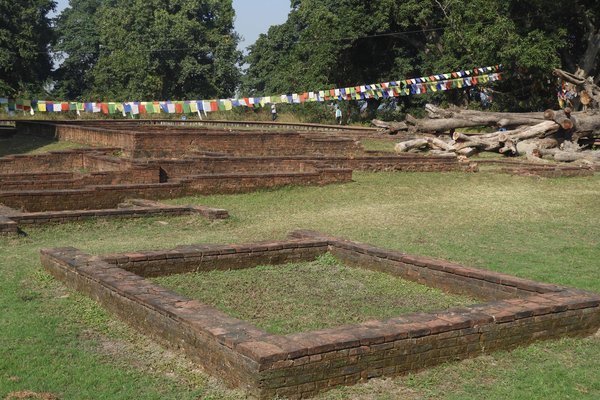Nepal
Tilaurakot-Kapilavastu
Tilaurakot-Kapilavastu, the Archaeological Remains of the Ancient Shakya Kingdom, comprises the archaeological remains of the ancient city of Kapilavastu of the Shakya Kingdom.
Gautama Buddha spent 29 years of his life here. The remains include three palaces, including that of the father of Gautama Buddha.
Community Perspective: In November 2024, Jarek found a site well-prepared already for being inscribed. The site can easily be accessed with private transport from Lumbini, which lies 40km away.
Site Info
Official Information
- Full Name
- Tilaurakot-Kapilavastu, the Archaeological Remains of the Ancient Shakya Kingdom (ID: 840)
- Country
- Nepal
- Status
-
On tentative list 1996
Site history
History of Tilaurakot-Kapilavastu
- 2025: Deferred
- Focus on Buddhist aspects and make it an extension of Lumbini
- 2019: Upstream Process
- 1996: Added to Tentative List
- Added to tentative list
- Type
- Cultural
- Criteria
- iv
- vi
Links
- UNESCO
- whc.unesco.org
All Links
UNESCO.org
- whc.unesco.org — whc.unesco.org
News Article
- July 14, 2025 kathmandupost.com — Tilaurakot misses out due to weak heritage diplomacy
- Jan. 23, 2023 myrepublica.nagariknetwork.com — Excavation of Maurya-era pond continues in a bid to list Tilaurakot in World Heritage Site
Community Information
- Community Category
- Archaeological site: South (East) Asian
Travel Information
Recent Connections
News
- kathmandupost.com 07/14/2025
- Tilaurakot misses out due to weak …
- myrepublica.nagariknetwork.com 01/23/2023
- Excavation of Maurya-era pond cont…
Recent Visitors
- GabLabCebu
- Roman Bruehwiler
- Alex Marcean
- Shandos Cleaver
- Joel on the Road
- Michael Turtle
- Stanislaw Warwas
Visitors of Tilaurakot-Kapilavastu
Community Reviews
Show full reviews
As I researched Tilaurakot before my June 2025 trip to Nepal, I wondered to myself why Nepal hadn't just nominated it as an extension to Lumbini. Perhaps, I thought, there was more than meets the eye to this ancient city. Upon visiting, I could definitely say there is – in the sense that most of the original remains of the palaces are BELOW GROUND. According to the local guide, those brick foundations that poke up above ground are already reconstructions, and the original state of the palace is now only visible as the bottom layer of clearly different-colored bricks on the ground. So all we actually have of this ancient city, other than the artifacts that are now stored in the nearby museum, is its layout. Even if this were an influential capital back in its day, which it barely was, the poor remains can barely warrant inscription on their own. Even Lumbini can be found in a better state than this today, though those remains are from the later Ashokan period. Any possible OUV, to me, is mostly tied to its role in Buddha's life. Easy thumbs down from me; inscription this year would've been bittersweet, and Tilaurakot would've become one of my lowest-ranked WHS on its own. For once, I couldn't have agreed more with the WHC's decision to defer as a possible extension to Lumbini.
Tilaurakot is the core of a common day-trip circuit from Lumbini, and many other minor sites scatter the countryside around Kapilvastu. Many …
Keep reading 1 comment
Site visited in November, 2024.
Nepali proposal for inscription in 2026. Once a capital of ancient Shakya capital city where Siddhartha Gautam spent his princely life before he became Lord Buddha. According to data presented on information board at the entrance Tilaurakot is the best preserved Early Historic city and hinterland in South Asia. Occupied between 900 BC and 1000 AC. Archaeologists revealed remains of early village transformed in the 6 century BC (Kushan Period) into a fortified grid-planned city with many later structures (temples, houses, palaces) constructed in brick. Development continued in the first millennium AD forming central walled complex, a large brick-lined pond in the middle of the city together with multiple residential and monastic structures around an industrial suburbs beyond city walls. The complex was rediscovered in 1890 and identified as ancient capital of Shakya Kingdom associated with Siddhartha Gautam.
The site looks well prepared for being a UNESCO heritage, partly fenced, well marked with information panels in Nepalese and English. Area within city walls is equipped with wooden walkways. The most important landmarks are: partly reconstructed town walls, Eastern Gate (where according to tradition Buddha started his journey of spiritual enlightenment), temple of Samai Mai with elephants statues, central pond and central structural complex. All monuments (except the temple that looks new and still in use) are preserved in similar style like in Lumbini. If you have time you can also see the remnants of twin stupas (outside the complex – leave the side …
Keep reading 0 comments
The best remains are the eastern gate and the 2 circular stupa foundations. It is difficult to imagine how this site could have been the wealthy city where Siddharta Gautama lived for the first 29 years of his life. Still it is worthy of being added as a WHS perhaps with Lumbini
Keep reading 0 comments
This site has not yielded any thing to prove conclusively that it is Kapilavastu. With due respect I must add that I can't understand how UNESCO team is so blind-folded to offer it the status of World Heritage Site, only perhaps because British team is working there.
Piprahwa on the contrary has yielded all evidences way back in 1971-1973 in form of relics and seiling with the legend Kapilavastu. Still it has received no honour forget about giving reconition to the excavator. WHY THIS PARTIALITY?
Keep reading 0 comments
